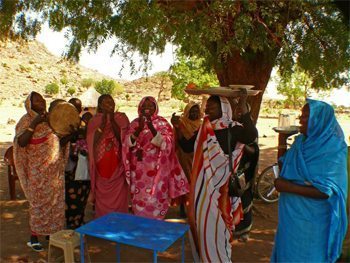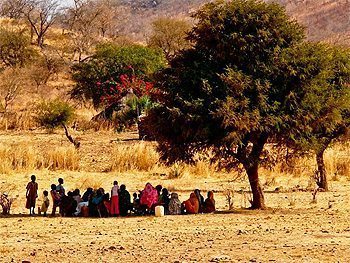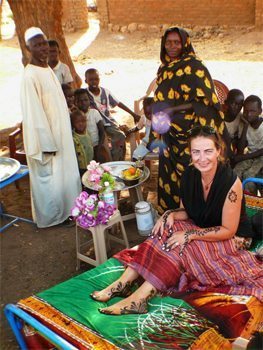Henna Rituals with Coffee
By Rene Bauer and Andrea Kaucka

I sit on the wooden bed under a huge fig tree. Around me the whole village has gathered. The women sing, on the table in front of me is a jug of “jjebennah” spreading its aromatic smell and I am waiting, wondering what is to come.
Another hot day following another hot night.
We sleep on beds which we had pulled out of the house and onto the veranda, thinking it might be cooler outside. Well, it isn’t! The thermometer just doesn’t want to drop below 29 centigrade, even in the late hours. And this is January, deep, frosty wintertime back home. In the morning, as every morning, we hear someone knocking a stick onto a metal barrel.
It’s a young boy driving his donkey cart through the dusty streets of Kadugli, pulling behind him a tank of drinking water which he sells to the households here.
He wakes up those, who managed to find sleep in this hot climate. After our morning coffee at the coffee-lady’s we stroll through town. We stop on the market for some breakfast – grilled locusts and deep-fried falafels.
Pre-marital Party

Around lunchtime we return to the small village of Hadjaralmak. Everything is prepared to show us the last days of a native woman before her wedding. Accompanied by singing and dancing, the tribeswomen bring me out of one of their huts. They make me sit down on this wooden bed in the shade of this huge fig tree. And already all children and women start gathering around me.
No one wants to miss out on a white woman being painted with traditional henna. Strong coffee, fresh fruits, water and karkadah – all is spread out on the small table in front of me. One of the bowls contains a not too appealing thick porridge with simple cutlery next to it.
Erotic rituals and wedding decoration Henna is the last preparation before the big wedding day. The groom is not allowed to attend this “prenuptial” party. The bride-to-be is leaving her single life and for the first time in her life is decorated during this so-called henna night.
The history of henna (al-hinna in Arabic) goes back way before the Christian period. Skins of women were decorated in the Middle East, Northern Africa and even as far as China, where it was used as a kind of erotic ritual. A long time ago, an Arabic woman would only decorate her hands as a sign of fertility. Here in Sudan, henna is being used as a decoration and to show that a woman is married.
From the fingertips, flowers and other abstract patterns are being drawn across the whole lower arm, even the palms of the hands are painted. The henna paste is applied to the soles of the feet as well and then continued in intricate patterns halfway up to the knee. The pattern itself, thickness and exact place depend on the henna artist. Every pattern is individual.

The traditional North African design consists of geometrical shapes with strong lines and abstract symbols. Sudanese tribes like black colour, in other countries henna can be brown, orange or even reddish. Beauty masks and „sauna“ belong to the pre-wedding ceremony as well.
Women especially use their traditional sauna for smoother skin. They make a hole into the ground in which they burn “taleh“ – a type of acacia with an orange-red bark.
They then cover themselves in a huge cloak of cowskin and crouch down over the hole. Their skin becomes darker and smoother.
All wedding preparations, including perfume making, henna and decorations, can take up to a few weeks. The mother of the bride, her sisters and aunts, all take part in making the bride-to-be beautiful. A Sudanese bride should be gorgeous, with beautiful decorations and a velvety skin.
Black on White

“So let’s go”, said Fatima excitedly. The kids start whispering and chatting, the women are singing. Fatima, the only Englishspeaking woman takes the role of a translator.” First, the henna leaves are pounded and ground to make a powder, which is then mixed with hot water. For a longer lasting decoration we add a little oil. Like this, the henna painting could last up to 30 days.” explains Fatima.
The henna paste is then applied to the soles of your feet, the toes and the fingertips. This is then left there to colour the skin underneath. In the meantime, the women will start painting other places,” she adds. Traditionally, only natural henna would be used, but nowadays, with artificial colours widely available, many tribeswomen tend to buy the artificial
stuff as it’s less work!
When drawing patterns, a little, triangular plastic bag is filled with the henna paste, then the tip is cut off to make a little hole for the colour to come out – that’s how they paint. They then start to draw patterns according to their fantasy. The women around me obviously love this and I start feeling like a real bride-to-be.

The paste on my feet and fingertips is starting to dry and I watch how skillfully one woman draws little flowers onto my shins – and this only with this little plastic bag full of colour. Every woman is eager to draw something onto my white skin. They get so carried away that they draw on places they normally wouldn’t paint.
The color has to stay on my skin for a while before it is washed off. I take a look at my arms and legs and must say that I’m impressed by their artistic skills. Henna stands out even more on white skin. After a woman got married, this henna procedure is repeated roughly every 2 weeks – the henna always has to look fresh.
It’s a married woman’s responsibility to keep it that way! After four hours all the painting is finished and the dried paint is washed off by the women. They then rub some perfumed oils on the fresh henna. The chief and his sister join us now and are amazed by my new look.
Freshly decorated and wrapped in a traditional “tobe,” the women take me with them – by minibus to the neighboring village. This time to a real pre-wedding ceremony. But I can’t see the bride-to-be. “She is in her mother’s and sisters’ hands, bids farewell to her single life and gets her henna,” explains the chief’s sister. I am surrounded by women in colourful tobes, they sing and dance – radiating a positive mood!
They Are Different After All

The fear had long gone from us. A lot of Sudanese speak a passable English and the ones who don’t, know how to somehow communicate. They are very different than described by the Western media.
“Don’t you want to try some local beer and spirit?” asked Jabir, our guide and now friend who put a lot of effort into showing us around. “Why not?” we say and off we go to the local “bar.” In one of those typical huts one woman had established her own bar.
Well, more or less just one table in the middle of the room, around it 2 angrebs (wooden beds) and a few plastic chairs. In between a few green plants. She serves us their local sorghum beer, called “marisa” and a spirit distilled from corn or whatever is available, called arragi.
The next day we leave Kadugli – revitalized and with unforgettable experiences. Sudanese people are beautiful, friendly and very hospitable. A country which we will definitely visit again!
- Arctic Winter Adventures in Sweden and Norway - January 10, 2021
- Kissed By an Elephant in Zimbabwe - November 22, 2020
- Sudan: Searching Bir Nurayet’s Treasures - November 13, 2019

